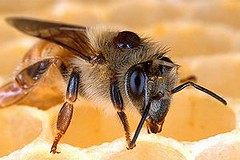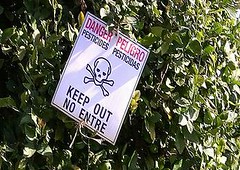美國聯邦政府2日發表報告指出,全美蜜蜂數量驟減乃由多重因素造成,包括寄生蟲、疾病、遺傳、營養不良和接觸殺蟲劑等,這可說是目前有關蜜蜂健康議題的最新科學共識。
美國農業部(USDA)和美國環保署官員表示,該報告總結了2012年10月召開的「蜜蜂健康全國權益關係人會議」的結論。
由聯邦研究人員和管理人員主導,該次會議參與者包括養蜂人、科學家、保育團體、養蜂供應商、相關製品製造商、農藥生產商、學者以及來自美加和歐洲的州政府與聯邦政府代表。會議的主要目的,是針對2006年起持續至今的蜂群衰竭失調現象,和各界探討目前科學家認為影響人工飼養蜜蜂健康最嚴重因素。
會議成果報告指出,「蜜蜂群體持續衰減,嚴重威脅許多商業作物的授粉需求。」
「蜜蜂健康狀況不佳是相當複雜的問題,由許多壓力因子共同影響造成。環保署承諾繼續和農業部、研究員、養蜂人、農民和社會大眾一起面對這個挑戰。」環保署代理署長佩西亞塞普(Bob Perciasepe)表示,聯邦政府機構正在與養蜂人、農民、農藥及種子公司合力「發展新設備和最佳管理措施,避免讓蜜蜂在覓食時接觸殺蟲劑,也正在想辦法減少種植時的殺蟲劑粉塵。」
「農藥對蜜蜂的急性和亞致死效應紀錄日益增加,已成為首要問題。」報告指出。
佩西亞塞普指出,環保署已有新的數據需求,並掌握新技術和分析方法,可評估蜜蜂和蜂群健康的亞致死效應。「我們今天發表的報告來自前所未有的合作經驗,這樣的合作勢必要繼續下去。」「如同報告所明確指出,我們已獲得重大進展,但要保護蜜蜂數量仍然有許多工作要做。」
農業部副部長麥瑞根(Kathleen Merrigan)說,「蜜蜂的健康和美國農業的發展息息相關,對我國長期農業生產力至關重要。」「影響蜜蜂的健康的因素是複雜的,我們的研究夥伴美國農業部和權益相關人們將投入因應此一挑戰。」
根據估計,全美國有三分之一的食品和飲料的產製過程中有授粉行為,主要的授粉昆蟲是蜜蜂。
 昆蟲授粉每年貢獻全美價值200至300億美元的農作物產量,但人工飼養蜂群數量下降對農民和果園等依賴商業授粉的產業造成龐大的壓力。
昆蟲授粉每年貢獻全美價值200至300億美元的農作物產量,但人工飼養蜂群數量下降對農民和果園等依賴商業授粉的產業造成龐大的壓力。
北達科他州詹姆斯鎮第四代商業養蜂人Zac Browning以生產蜂蜜為業並提供愛達荷州、北達科他州、華盛頓州和加州的農作物授粉服務。身為前美國養蜂人聯盟主席和現任委員會成員,他熟知全國蜜蜂的實際情況。
Browning在電話中介紹此份報告並告訴記者,「我們的蜜蜂數量僅能勉強應付授粉需求。」「報告明確表示,造成蜜蜂數量下降的原因複雜,但並不神秘。」「這份報告做得很好,分析出多重的壓力因子。我們需要多面向的解決方案。」
「依我的親身經驗,」Browning說,「我的蜜蜂減少數量是2012年的2倍。我們觀察到的症狀並不符合蜂群衰竭失調。多重因素造成我們的蜜蜂數量減少:秋季的乾旱造成蜜蜂的壓力,部分是因為暴露於農藥,也有和女王蜂本身問題有關的自然因素。乾旱和這種種因素交互作用,讓蜂群缺乏食物。缺少棲息地,而且周邊環境資源不足以供給蜂群。」
在歐洲食品安全局發表報告指出含三種新菸鹼類殺蟲劑的粉塵和花粉對蜜蜂造成「嚴重風險」後,歐盟宣布禁用這些殺蟲劑。但是歐巴馬政府並未考慮比照辦理。
 環保署化學安全和污染防治局代理副局長Jim Jones說,「歐洲尚未完全禁止這三種農藥,他們還在走程序。我們讓科學結果引導我們的決定。最重要的是獲得科學上的正確。如果我們做了錯誤決定,可能造成極高的社會成本。農藥為美國農民和消費者帶來益處,讓食物有合理的價格。我們必須確保採取準確和有意義的措施。」
環保署化學安全和污染防治局代理副局長Jim Jones說,「歐洲尚未完全禁止這三種農藥,他們還在走程序。我們讓科學結果引導我們的決定。最重要的是獲得科學上的正確。如果我們做了錯誤決定,可能造成極高的社會成本。農藥為美國農民和消費者帶來益處,讓食物有合理的價格。我們必須確保採取準確和有意義的措施。」
該報告指出最迫切的農藥研究問題是「確定田野中的實際農藥暴露以及對蜜蜂的影響,對蜂蜜健康和蜂群生產力的衝擊和潛在風險。」
美國農業部也正從其他方面改善蜜蜂的生存。農業部認為蜜蜂數量下降和過去幾年開放覓食區域的縮小有關。報告指出,「隨著商品價格上漲,經濟和農業發展有所改變,玉米等行栽作物增加了,包括過去未開發的地區亦然」,土地利用的變化難辭其咎。
美國農業部國家食品和農業研究所主任瑞馬斯瓦米(Sonny Ramaswamy)博士在電話中告訴記者,「美國農業部正在努力改善聯邦土地的授粉環境。」
瑞馬斯瓦米指出,「我們正在進行一項全國性調查,並將依照調查結果,和農民與農業主合作改善其土地上的蜜蜂棲息地。」
報告也顯示,現代的農業實務讓授粉變得困難,尤其是當玉米田的比例越來越高。Browning說,玉米對蜜蜂沒有任何好處。
「如果能提供授粉昆蟲更好的食物來源,就能有效改善授粉昆蟲的健康。」美國農業部蜜蜂研究實驗室主任研究員白提斯(Jeff Pettis)說,「我們正在尋找可供蜜蜂覓食的聯邦土地。」
國家權益關係人會議蜜蜂健康狀況報告指出:
- 寄生蜂蟹蟎被認為是美國和其他國家蜂群衰減的主要因素。蜂農用以控制蜂巢中蟎蟲的化學藥劑具廣泛抗藥性。美國已發現新品種病毒,許多和蜂群衰竭失調有關。
- 美國蜂群需要增加遺傳多樣性。遺傳變異提高蜜蜂在不同環境中保持體溫穩定的能力、對抗疾病的能力和工蜂生產力。
- 養蜂應更強調衛生等條件,以改善蜜蜂對抗蜂蟹蟎和美洲幼蟲病的能力。
- 營養對蜜蜂個體和蜂群的壽命有重大影響。營養不良讓蜜蜂更容易受到疾病和寄生蟲的威脅。蜜蜂需要更好的食物來源和各種植物,以維持蜂群健康。
- 聯邦和合作州政府應考慮介入土地管理,以更有效利用現有的營養糧食,促進蜜蜂健康,並且保護蜜蜂,讓蜜蜂遠離殺蟲劑處理過的地區。
- 雖有蜜蜂相關的最佳管理措施和農藥使用辦法,但尚未被作物生產相關產業人員廣泛或系統性地遵循。農民和養蜂人之間需要清楚溝通協調,權益關係人間須有效合作,才能保護蜜蜂免受農藥傷害。
養蜂人強調,需要準確和及時的蜜蜂死亡事件通報、監測和執法作為。
參與製作報告的單位包括美國農業部害蟲管理政策辦公室、國家食物與農業機構、農業研究所、動植物衛生檢驗局、國家資源保護局、環保署和賓州州立大學。
下載美國農業部「蜂群衰竭失調督導委員會」的報告 http://www.usda.gov/documents/ReportHoneyBeeHealth.pdf 。
Multiple factors are responsible for the steep decline in honey bees across the United States, including parasites and disease, genetics, poor nutrition and pesticide exposure, federal government officials reported today, releasing a new scientific consensus on honey bee health.
The U.S. Department of Agriculture and the U.S. Environmental Protection Agency officials said the reportsummarizes the conclusions of the National Stakeholders Conference on Honey Bee Health last October.
Led by federal researchers and managers, the meeting included: beekeepers, scientists, advocacy groups, beekeeping supply manufacturers, commodity groups, pesticide producers, academics, and state and federal government representatives from the United States, Canada, and Europe. It was convened to survey the current state of knowledge about the primary factors that scientists believe have the greatest impact on managed bee health now that Colony Collapse Disorder has persisted since 2006.
"Overall losses continue to be high and pose a serious threat to meeting the pollination service demands for several commercial crops," states the meeting's outcome report.
"The decline in honey bee health is a complex problem caused by a combination of stressors, and at EPA we are committed to continuing our work with USDA, researchers, beekeepers, growers and the public to address this challenge," said Acting EPA Administrator Bob Perciasepe.
Federal government agencies are working with beekeepers, growers, pesticide and seed companies, said Perciasepe, "advancing new equipment and best management practices to avoid pesticide exposure to bees when they are foraging and refining ways to reduce the pesticide dust when planting."
"Acute and sublethal effects of pesticides on honey bees have been increasingly documented, and are a primary concern," the report states.
Perciasepe said that EPA has new data requirements and new techniques and analysis for assessing sublethal effects on bees and colony health.
"The report we've released today is the product of unprecedented collaboration, and our work in concert must continue," Perciasepe said. "As the report makes clear, we've made significant progress, but there is still much work to be done to protect the honey bee population."
"There is an important link between the health of American agriculture and the health of our honeybees for our country's long term agricultural productivity," said Agriculture Deputy Secretary Kathleen Merrigan. "The forces impacting honeybee health are complex and USDA, our research partners, and key stakeholders will be engaged in addressing this challenge."
An estimated one-third of all food and beverages consumed in the United States are made possible by pollination, mainly by honey bees.
Across the country, pollination contributes to crop production worth $20-30 billion in agricultural production annually, but a decline in managed bee colonies puts great pressure on farmers and orchardists who rely on commercial pollination services.
Zac Browning, a fourth generation commercial beekeeper from Jamestown, North Dakota, produces honey and provides crop pollination services in North Dakota, Idaho, Washington, and California. As a past president and current legislative committee member of the American Beekeeping Federation, he knows the condition of bees across the country.
"We're on the brink," of failing to supply enough bees to meet the demand for pollinators, he told reporters on a conference call today introducing the report.
"The report makes it clear that bee decline is complicated, but it is not a mystery," said Browning. "The report does a good job in breaking down the multi- stressors. Solutions will be multifacted too."
"In my own operation," said Browning, "my bee losses are double what they were in 2012. The symptoms we saw were not consistent with Colony Collapse Disorder. Our losses were from multiple factors: drought-stressed bees in the fall, some were the result of pesticide exposure, some were considered natural due to queen failure. We also had hives succumbing to dearth of food due to drought and combination of those factors interacting. There's not enough habitat and what is left on the periphery is not enough to support bees."
While the European Union last week placed restrictions on three neonicotinoid insecticides harmful to bees after a European Food Safety Authority report identified "high acute risks" for bees in dust and pollen contaminated with these pesticides, Obama Administration officials are not considering pesticide restrictions.
Jim Jones, acting assistant administrator, EPA Office of Chemical Safety and Pollution Prevention, said, "The Europeans have not banned the three pesticides yet, they're involved in a processes. We let science drive the outcome of our decisions. It's important to get the science correct. There are nontrival costs to society if we get this wrong. Pesticide products provide benefits to farmers, and to consumers, providing affordable food in the United States. We want to make sure we make accurate and meaningful moves."
The report finds the most pressing pesticide research questions relate to "determining actual pesticide exposures and effects of pesticides to bees in the field and the potential for impacts on bee health and productivity of whole honey bee colonies."
The USDA is working along other lines to improve bee survival. They are addressing the decline in availability of open foraging areas over the last few years. The report says land use changes are to blame, "driven, in part, by economic and agricultural developments such as increased planting of row crops, such as corn, as commodity prices have risen, and in sites that formerly were undisturbed."
Dr. Sonny Ramaswamy, director of the U.S. Department of Agriculture's National Institute of Food and Agriculture told reporters on the call, "At the USDA, we are working to improve pollinator-friendly habitats on federal land."
"We are conducting a national survey to identify honeybee pests that will guide our work with farmers and ranchers to incorporate honeybee habitat enhancements on their lands," Ramaswamy said.
Modern farming practices are making things difficult for pollinators, the report shows, especially when large and increasing swathes of farmland are being planted to corn, a crop that Browning says is of no benefit to honeybees.
"If we had better forage for pollinators we'd go a long ways in inproving pollinator health," said Dr. Jeffery Pettis, bee research leader with the USDA Agricultural Research Service. "We're looking at federal lands that might be made available for bees."
The Report on the National Stakeholders Conference on Honey Bee Health states:
The parasitic Varroa mite is recognized as the major factor underlying colony loss in the United States and other countries. There is widespread resistance to the chemicals beekeepers use to control mites within the hive. New virus species have been found in the United States, several associated with Colony Collapse Disorder.
• U.S. honeybee colonies need increased genetic diversity. Genetic variation improves bees' ability to keep body temperature steady even if the surrounding environment is different, as well as disease resistance and worker productivity.
• Honey bee breeding should emphasize traits such as hygienic behavior that confer improved resistance to Varroa mites and diseases such as American foulbrood.
• Nutrition has a major impact on individual bee and colony longevity. A nutrition-poor diet can make bees more susceptible to harm from disease and parasites. Bees need better forage and a variety of plants to support colony health.
• Federal and state partners should consider actions affecting land management to maximize available nutritional forage to promote and enhance good bee health and to protect bees by keeping them away from pesticide-treated fields.
• Best Management Practices associated with bees and pesticide use, exist, but are not widely or systematically followed by members of the crop-producing industry. There is a need for informed and coordinated communication between growers and beekeepers and effective collaboration between stakeholders on practices to protect bees from pesticides.
• Beekeepers emphasized the need for accurate and timely bee kill incident reporting, monitoring, and enforcement.
Those involved in developing the report include: USDA's Office of Pest Management Policy, National Institute of Food and Agriculture, Agricultural Research Service, Animal and Plant Health Inspection Service, National Resource Conversation Service as well as the EPA and Pennsylvania State University.
Please click here to view the report, which will inform the work of the USDA's Colony Collapse Steering Committee.http://ens-newswire.com/2013/05/02/honey-bee-decline-due-to-complex-multiple-factors/
※ 全文及圖片詳見:ENS







